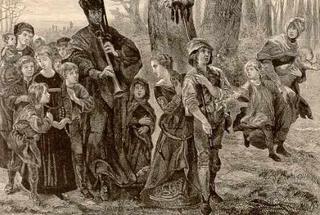The Pied Piper


1376 (dates vary) The Pied Piper came to Hamelin (Hameln), a town in Lower Saxony, Germany, and led the children out of town.
The story of the Pied Piper (Rattenfänger) of Hamelin was popularised in German by the Brothers Grimm and in English by the poet Robert Browning (1812 - 1889) in his narrative poem of that name.
It comes from an old German legend translated into English in 1605 by Richard Verstegan, English publisher and antiquarian, who gave this as the date in A Restitution of Decayed Intelligence. (A 14th-century account gives the date as June 26, 1284.) The oldest remaining source is a note in Latin prose, made one and a half centuries later (1430 - 1450) as an addition to a 14th-century manuscript from Lüneburg.
The stranger, dressed in pied, or multicoloured, clothing, offered to rid the town of Hamelin of its plague of rats, for an agreed price. He played his pipe and the rats followed his beguiling tune down to the Weser River, all drowning. The burghers of Hamelin refused to pay the piper, so in revenge he began piping his charming song and the town’s children, entranced, followed him to a mountain cave, which as if by magic sealed itself shut.
The historical record
There are historical records of a stained glass window in the church of Hamelin that dates from before 1300, depicting the children’s exodus. Unfortunately, the picture has been missing since the window was replaced around 1660. A rhyme appeared with this window, reporting that a piper dressed in many colours led 130 children away from Hamelin ...







0 Comments:
Post a Comment
<< Home